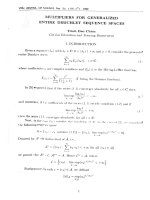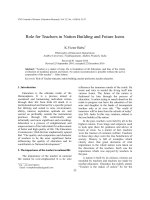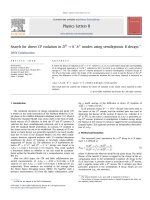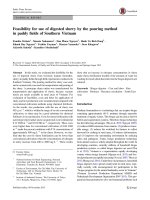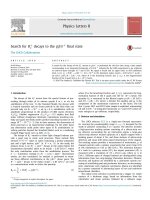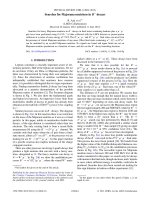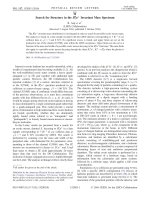DSpace at VNU: Search for lepton flavour violation in Z decays
Bạn đang xem bản rút gọn của tài liệu. Xem và tải ngay bản đầy đủ của tài liệu tại đây (529.05 KB, 8 trang )
Letters B 316 (1993) 427-434
North-Holland
Physics
PHYSICS LETTERS B
Search for lepton flavour violation in Z decays
L3 Collaboration
O. Adriani o, M. Aguilar-Benitez x, S. Ahlen i, j. Alcaraz P, A. Aloisio aa, G. AlversonJ,
M.G. Alviggi aa, G. Ambrosi af, Q. An q, H. Anderhub at, A.L. Anderson n, V.P. Andreev aj,
T. Angelescu k, L. A n t o n o v an, D. Antreasyan g, P. Arce x, A. Arefiev z, A. A t a m a n c h u k aj,
T. A z e m o o n c, T. Aziz h, P.V.K.S. Baba q, P. Bagnaia ai, J.A. Bakken ah, R.C. Ball c, S. Banerjee h,
J. Bao e, R. Barillbre p, L. Barone ai, A. Baschirotto Y, R. Battiston af, A. Bay r, F. Becattini o
J. Bechtluft a, R. Becker a, U. Becket n'at, F. Behner at, J. Behrens at, Gy.L. Bencze e, J. Berdugo x,
P. Berges n, B. Bertucci af, B.L. Betev an,at, M. Biasini af, A. Biland at, G.M. Bilei af, R. Bizzarri ai,
J.J. Blaising d, G.J. Bobbink p,b, R. Bock a, A. B6hm a, B. Borgia ai, M. Bosetti Y, D. Bourilkov ac,
M. Bourquin r, D. Boutigny v, B. Bouwens b, E. Brambilla aa, J.G. Branson ak, I.C. Brock as,
M. Brooks v, A. Bujak aq, J.D. Burger n, W.J. Burger r, J. Busenitz ap, A. Buytenhuijs ac, X.D. Caiq,
M. Capell n, M. Caria af, G. Carlino aa, A.M. Cartacci o, R. Castello Y, M. Cerrada x, F. Cesaroni ai,
Y.H. Chang n, U.K. Chaturvedi q, M. Chemarin w, A. Chen av C. Chen f, G. Chen f, G.M. Chert f,
H.F. Chert s, H.S. Chen f, M. Chen n, W.Y. Chen av, G. Chiefari aa, C.Y. Chien e, M.T. Choi ao,
S. Chung n, C. Civinini °, I. Clare n, R. Clare n, T.E. Coan v, H.O. Cohn aa, G. Coignet d,
N. Colino P, A. Contin g, F. Cotorobai k X.T. Cui q, X.Y. Cui q, T.S. Dai ", R. D'Alessandro o,
R. de Asmundis aa, A. Degrd d, K. Deiters ar, E. D6nes e, P. Denes ah, F. DeNotaristefani ai,
M. Dhina at , D. DiBitonto ap , M. Diemoz a,, H.R. Dimitrov an , C. Dionisi ai, M. Dittmar at,
L. Djambazov at, M.T. Dova q, E. Drago aa, D. Duchesneau r, P. Duinker b, I. Duran a~, S. Easo af,
H. El M a m o u n i w, A. Engler as, F.J. Eppling n, F.C. Ern6 b, P. Extermann r, R. Fabbretti at,
M. Fabre at, S. Falciano ai, S.J. Fan am, O. Fackler u, J. Fay w, M. Felcini P, T. Ferguson ag,
D. Fernandez x, G. Fernandez x, F. Ferroni ai, H. Fesefeldt a, E. Fiandrini af, J.H. Field r,
F. Filtbaut ac, P.H. Fisher e, G. Forconi r, L. Fredj r, K. Freudenreich at, W. Friebel as,
M. F u k u s h i m a n, M. Gailloud t, Yu. Galaktionov z,n, E. Gallo o, S.N. Ganguli p,h, p. Garcia-Abia x,
D. Gele w, S. Gentile ai, N. Gheordanescu k, S. Giagu ai, S. Goldfarb j, Z.F. Gong s, E. Gonzalez x,
A. Gougas e, D. Goujon r, G. Gratta ae, M. Gruenewald p, C. Gu q, M. Guanziroli q, J.K. Guo am,
V.K. Gupta ab, A. Gurtu h, H.R. Gustafson c, L.J. Gutay aq, K. Hangarter a, B. H a r t m a n n a,
A. Hasan q, D. Hauschildt b, C.F. He am, J.T. He f, T. Hebbeker p, M. Hebert ak, A. Herv6 p,
K. Hilgers a, H. Hofer at, H. Hoorani r, G. Hu q, G.Q. Hu am B. Ille w, M.M. Ilyas q, V. Innocente P,
H. Janssen P, S. Jezequel d, B.N. Jin f, L.W. Jones c, I. Josa-Mutuberria p, A. Kasser t,
R.A. Khan q, Yu. Kamyshkov ad p. Kapinos aj,as, J.S. Kapustinsky v, y. Karyotakis P, M. Kaur q,
S. Khokhar q, M.N. Kienzle-Focacci r, J.K. Kim a°, S.C. Kim a°, Y.G. Kim a°, W.W. Kinnison v,
A. Kirkby ae, D. Kirkby ae, S. Kirsch as, W. Kittel ac, A. Klimentov n,z, R. Kl6ckner a,
A.C. K6nig ac, E. Koffeman b, O. Kornadt a, V. Koutsenko n,z, A. Koulbardis aj, R.W. Kraemer as,
T. Kramer n, V.R. Krastev an,af, W. Krenz a, A. Krivshich aj, H. Kuijten ac, K.S. K u m a r m,
A. Kunin n,z, G. Landi o, D. Lanske a, S. Lanzano aa, A. Lebedev n, p. Lebrun w, p. Lecomte at,
P. Lecoq p, P. Le Coultre at, D.M. Lee v, J.S. Lee a°, K.Y. Lee a°, I. Leedom J, C. Leggett c,
J.M. Le G o l f p, R. Leiste as, M. Lenti °, E. Leonardi ai, C. Li s'q, H.T. Li f, P.J. Li am, J.Y. Liao am,
W.T. Lin av, Z.Y. Lin s, F.L. Linde b, B. L i n d e m a n n a, L. Lista aa, Y. Liu q, W. L o h m a n n as,
E. Longo ai, Y.S. Lu f, J.M. Lubbers p, K. Liibelsmeyer a, C. Luci ai, D. Luckey g,n, L. Ludovici ai,
0370-2693/93/$ 06.00 (g) 1993-Elsevier Science Publishers B.V. All rights reserved
427
Volume 316, number 2,3
PHYSICS LETTERSB
21 October 1993
L. Luminari ai, W. Lustermann as, J.M. Ma f, W.G. Ma s, M. MacDermott at, R. Malik q,
A. Malinin z, C. Mafia x, M. Maolinbay at, p. Marchesini at, F. Marion d, A. Marin i, j.p. Martin w,
L. Martinez-Laso x, F. Marzano ai, G.G.G. Massaro b, K. M a z u m d a r r, P. McBride m,
T. M c M a h o n aq, D. McNally at, M. Merk aLL. Merola aa, M. Meschini °, W.J. Metzger ac, Y. Mi t,
A. Mihul k, G.B. Mills v, Y. Mirq, G. Mirabelli ai, J. Mnich a, M. M611er a, B. Monteleoni °,
R. Morand d, S. Morganti ai, N.E. Moulai q, R. M o u n t ae, S. Miiller a, A. Nadtochy aj, E. Nagy t,
M. Napolitano aa, F. Nessi-Tedaldi at, H. N e w m a n ae, C. Neyer at, M.A. Niaz q, A. Nippe a,
H. Nowak as, G. Organtini ai, D. Pandoulas a, S. Paoletti ai, p. Paolucci aa, G. Pascale ai,
G. Passaleva o,af, S. Patricelli aa, T. Paul e, M. Pauluzzi af, C. Paus a, F. Pauss at, y . j . Pei a,
S. Pensotti Y, D. Perret-Gallix d, J. Perrier r, A. Pevsner e, D. Piccolo aa, M. Pieri v, P.A. Pirou6 ah,
F. Plasil aa, V. Plyaskin z, M. Pohl at, V. Pojidaev z,°, H. Postema n, Z.D. Qi am, J.M. Qian c,
K.N. Qureshi q, R. Raghavan h, G. Rahal-Callot at, P.G. RancoitaY, M. Rattaggi Y, G. Raven b,
P. Razis ab, K. Read ad, D. Ren at, Z. Ren q, M. Rescigno ai, S. Reucroft J, A. Ricker a, S. R i e m a n n as,
B.C. Riemers aq, K. Riles c, O. Rind c, H.A. Rizvi q, S. Ro a°, F.J. Rodriguez x, B.P. Roe c,
M. R6hner a, L. Romero x, S. Rosier-Lees d, R. Rosmalen ac, Ph. Rosselet t, W. van Rossum b,
S. Roth a, A. Rubbia n, J.A. Rubio p, H. Rykaczewski at, M. Sachwitz as, J. Salicio p, J.M. Salicio x,
G.S. Sanders v, A. Santocchia af, M.S. Sarakinos", G. Sartorelli s,q, M. Sassowsky a, G. Sauvage d,
V. Schegelsky aj, D. Schmitz a, p. Schmitz a, M. Schneegans d, H. Schopper au, D.J. Schotanus ac,
S. Shotkin n, H.J. Schreiber as, J. Shukla aL R. Schulte a, S. Schulte a, K. Schultze a, J. Schwenke a,
G. Schwering a, C. Sciacca aa, I. Scott m, R. Sehgal q, P.G. Seiler at, J.C. Sens p,b, L. Servoli af
I. Sheer ak, D.Z. Shen am, S. Shevchenko ae, X.R. Shi ae, E. Shumilov z, V. Shoutko z, D. Son ao,
A. Sopczak P, V. Soulimov aa, C. Spartiotis e, T. Spickermann a, p. Spillantini o, R. Starosta a,
M. SteuerS.n, D.P. Stickland ah, F. Sticozzi n, H. Stone ah, K. Strauch m, B.C. Stringfellow aq,
K. Sudhakar h, G. Sultanov q, L.Z. Sun s,q, G.F. Susinno r, H. Suter at, J.D. Swain q, A.A. Syed ac,
X.W. Tang f, L. TaylorJ, G. Terzi Y, Samuel C.C. Ting n, S.M. Ting n, M. Tonutti a, S.C. Tonwar h,
J. T6th t, A. Tsaregorodtsev aj, G. Tsipolitis ag, C. Tully ah, K.L. Tung f, J. Ulbricht at, L. Urbfin t,
U. Uwer a, E. Valente ai, R.T. Van de Walle ac, I. Vetlitsky z, G. Viertel at, p. Vikas q, U. Vikas q,
M. Vivargent d, H. Vogel aL H. Vogt as, I. Vorobiev z, A.A. Vorobyov aj, L. Vuilleumier t,
M. Wadhwa d, W. Wallraff a, C. Wang n, C.R. Wang s, X.L. Wang s, Y.F. Wang n, Z.M. Wang q,s,
C. Warner a, A. Weber a, j. Weber at, R. Weill t, T.J. Wenaus u, j. Wenninger r, M. White n,
C. Willmott x, F. Wittgenstein p, D. Wright ah, S.X. Wu q, S. Wynhoff a, B. Wystouch n,
Y.Y. Xie am, J.G. Xu f, Z.Z. Xu s, Z.L. Xue ara, D.S. Yan am, B.Z. Yang s, C.G. Yang f, G. Yang q,
C.H. Ye q, J.B. Ye s, Q. Ye q, S.C. Yeh av, Z.W. Yin am, J.M. You q, N. Yunus q, M. Yzerman b,
C. Zaccardelli ae, N. Zaitsev aa, P. Z e m p at, M. Zeng q, Y. Zeng a, D.H. Zhang b, Z.P. Zhang s'q,
B. Zhou i, G.J. Zhou f, J.F. Zhou a, R.Y. Zhu ae, A. Zichichi g'P'q and B.C.C. van der Zwaan b
a L Physikalisches lnstitut, R W T H , W-5100 Aachen, FRG I
IlL Physikalisches lnstitut, R WTH, W-5100 Aachen, FRG l
b National Institute for High Energy Physics, NIKHEF, NL-IO09 DB Amsterdam, The Netherlands
c University of Michigan, Ann Arbor, MI 48109, USA
d Laboratoire d'Annecy-le-Vieux de Physique des Particules, LAPP, IN2P3-CNRS. B.P. 110, F-74941 Annecy-le-Vieux
Cedex, France
e Johns Hopkins University, Baltimore, MD 21218, USA
f Institute of High Energy Physics, IHEP, 100039 Beijing, China
g INFN - Sezione di Bologna, 1-40126 Bologna, Italy
h Tata Institute of Fundamental Research, Bombay 400 005, India
i Boston University, Boston, MA 02215, USA
J Northeastern University, Boston, MA 02115, USA
k Institute of Atomic Physics and University of Bucharest, R-76900 Bucharest, Romania
t Central Research Institute for Physics of the Hungarian Academy of Sciences, H-1525 Budapest 114, Hungary 2
428
Volume 316, number 2,3
PHYSICS LETTERS B
21 October 1993
m Harvard University, Cambridge, MA 02139, USA
n Massachusetts Institute of Technology, Cambridge, MA 02139, USA
o INFN - Sezione di Firenze and University of Florence, 1-50125 Florence, Italy
P European Laboratory for Particle Physics, CERN, CH-1211 Geneva 23, Switzerland
q World Laboratory, FBLJA Project, CH-1211 Geneva 23, Switzerland
r University of Geneva, CH-1211 Geneva 4, Switzerland
s Chinese University of Science and Technology, USTC, Hefei, Anhui 230 029, China
t University of Lausanne, CH-1015 Lausanne, Switzerland
u Lawrence Livermore National Laboratory, Livermore, CA 94550, USA
v Los Alamos National Laboratory, Los Alamos, NM 87544, USA
w Institut de Physique NuclJaire de Lyon, IN2P3-CNRS, UniversitJ Claude Bernard. F-69622 Villeurbanne Cedex,
France
x Centro de Investigaciones Energeticas, Medioambientales y Tecnologicas, CIEMAT, E-28040 Madrid, Spain
Y INFN - Sezione di Milano, 1-20133 Milan, Italy
z Institute of Theoretical and Experimental Physics, ITEP, Moscow, Russia
a a 1NFN - Sezione di Napoli and University of Naples, 1-80125 Naples, Italy
ab Department of Natural Sciences, University of Cyprus, Nicosia, Cyprus
a¢ University of Nymegen and NIKHEE NL-6525 ED Nymegen, The Netherlands
ad Oak Ridge National Laboratory, Oak Ridge, TN 37831, USA
a e California Institute of Technology, Pasadena, CA 91125, USA
a f INFN - Sezione di Perugia and Universitiz Degli Studi di Perugia, 1-06100 Perugia, Italy
as Carnegte Mellon University, Pittsburgh, PA 15213, USA
ah Princeton University, Princeton, NJ 08544, USA
ai INFN - Sezione di Roma and University of Rome, "La Sapienza", 1-00185 Rome, Italy
aj Nuclear Physics Institute, St. Petersburg, Russia
ak University of California, San Diego, CA 92093, USA
at Dept. de Fisica de Particulas Elementales, Univ. de Santiago, E-15706 Santiago de Compostela, Spain
am Shanghai Institute of Ceramics, SIC, ShanghaL China
an Bulgarian Academy of Sciences, Institute of Mechatronics, BU-I 113 Sofia, Bulgaria
ao Center for High Energy Physics, Korea Advanced Inst. of Sciences and Technology, 305- 701 Taejon, Republic of Korea
ap University of Alabama, Tuscaloosa, AL 35486, USA
aq Purdue University, West Lafayette, IN 47907, USA
ar Paul Scherrer Institut, PSI, CH-5232 Villigen, Switzerland
as D E S Y - Institut fiir Hochenergiephysik, 0-1615 Zeuthen, FRG
at Eidgen6ssische Technische Hochschule, ETH Ziirich, CH-8093 Zarich, Switzerland
au University of Hamburg, W-2000 Hamburg, FRG
av High Energy Physics Group, Taiwan, China
Received 9 August 1993
Editor:. K. Winter
We have searched for lepton flavour violation in Z boson decays into lepton pairs using all data collected with the L3 detector
during the 1990, 1991 and 1992 runs on an event sample corresponding to 1 500 000 2?s produced. At the 95% confidence level
the upper limits on the branching ratio for Z--,etz is 0.6X 10-s, for Z--.er this is 1.3X 10-5 and for Z--*/zTthis is 1.9X 10-s.
1. I n t r o d u c t i o n
In the Standard Model [ 1,2 ] lepton flavour is c o n 1 Supported by the German Bundesministerium t'dr
Forschung und Technologie.
2 Supported by the Hungarian OTKA fund under contract
number 2970.
served. However, there is no gauge principle requiring this conservation. Different models [ 3-9 ], beyond the Standard Model, allow processes which
v i o l a t e lepton flavour conservation. In theories where
such violation arises through mixing with new p a n i cles [4,6], the branching ratios for such processes,
e.g. Z--./zr, have been calculated to be as large as 10 -4
in certain models. The observation o f such decays
429
Volume 316, number 2,3
PHYSICS LETTERSB
would be a clear indication of physics beyond the
Standard Model. Here a search for lepton flavour violation in Z decays into e/t, ez and/tT is reported using the data collected with the L3 detector during the
1990, 1991 and 1992 runs on an event sample corresponding to l 500 000 Z's produced. Direct searches
for lepton flavour violation [ 10-17 ] have been performed previously by L3 and other experiments.
Stringent constraints on violation o f / t flavour exist
from low-q 2 reactions, such as the absence of the decay/t--,eee [ 14 ], providing an upper limit [ 18 ] on
Br ( Z--*e/t) of 6.6 × 10- ~3. Searches for neutrinoless
r decays r~eee, z--./t/t/t [12,13] lead to much less
stringent limits on Br(Z--.er) and Br(Z--./tr).
2. The 1.3 detector
The fiducial solid angle of the L3 detector [ 19 ] is
99% of 4n. The detector consists of a time expansion
chamber (TEC) for tracking charged particles, a high
resolution electromagnetic calorimeter of BGO crystals, a barrel of scintillation counters, a hadron calorimeter with uranium absorber and proportional wire
chamber readout and a muon spectrometer. The luminosity is determined from small-angle Bhabha
scattering using BGO electromagnetic calorimeters in
the polar angle ranges 0 and n - 0 between 24.93 and
69.94 mrad. All subdetectors are installed inside a 12
m diameter solenoidal magnet which provides a uniform 0.5 T field along the beam direction. A detailed
description of each detector subsystem, and its performance, is given in refs. [ 11,19 ].
3. Signature and background
The expected experimental signature of Z--.eg,
Z - , / t r and Z--.er is an electron or muon with an energy close to the beam energy recoiling against a different type of lepton or hadrons from tau decay. The
background arises from Standard Model leptonic final states and can be divided into two classes: (i) incorrectly reconstructed e+e - and g + / t - events; (ii)
r+T - events with one or both of the taus decaying
into a moon or electron which carries almost all the
energy of the tau. Good muon and electron energy
resolution is essential to reduce the latter background
430
21 October 1993
while retaining a high detection efficiency. The energy resolution for electrons determined from Bhabha
events is 1.3% at 45 GeV, while the muon momentum resolution determined from dimuon events is
2.5%.
About 300 000 Monte Carlo events were generated
to study Standard Model backgrounds from e÷e - ,
/t+/t-, r ÷ z - and four-fermion channels using various Monte Carlo generators [20-23]. A modified
version of the KORALZ [20] Monte Carlo program
was used to generate signal events.
4. Preselection and lepton identification
The preselection cuts, used to select a data sample
containing high energy dilepton events of all types,
are the following:
- The total energy is greater than 30 GeV.
- The number of jets is 2.
- The number of tracks in the TEC is between 1
and 6, to remove hadron events.
- The number of calorimeter clusters is less than
15, to remove hadron events.
- The acolinearity angle between the two jets is
smaller than 20 °, to remove radiative events.
Jets are reconstructed using a two step algorithm
[24] which groups the energy deposited in calorimeters into clusters before collecting the clusters into
jets. The clustering algorithm normally reconstructs
one cluster for each muon, electron or photon shower,
and a few clusters for a hadronic decay of a single z.
Under the above definition of a jet, particles with only
one cluster, like electrons, are also considered as jets.
An electron is defined as a geometrical cluster in
the electromagnetic calorimeter with an energy larger
than 2 GeV matched with a TEC track in the (R, ¢)
plane within l0 mrad. The cluster shower profile
should be consistent with that of an electron, i.e. we
require 0.97
around the most energetic one, and X2 < 2, where X 2
is obtained by fitting the shape of the cluster to the
mean electron shower profile. The electron candidate
must be in the fiducial volume defined by
Icos01 <0.9.
Muons are identified and their momenta measured in the muon chamber system surrounding the
Volume 316, number 2,3
PHYSICSLETTERSB
calorimeters. To be accepted, a muon track must have
one track segment in each of the three chamber layers. The accepted muon track must extrapolate back
to within 100 mm of the nominal vertex position in
the transverse plane and 200 mm in the longitudinal
plane. The muon candidate energy must be greater
than 3 GeV and it must be in the fiducial volume defined by ]cos 0] < 0.75.
5. Z ~ e t i
channel
For the Z~el* channel we require one jet to be consistent with a beam energy electron and the other one
to be consistent with a beam energy muon. This type
of event is essentially free of background and allows
a less restrictive selection cut on lepton energy than
Z - , e z and Z ~ g z channels. Fig. 1 shows the normalised electron energy versus the normalised muon momentum for the data events selected. Signal events
will populate the region where both normalised energies are close to unity. We require that for the electron candidate the normalised energy should be
greater than 0.96 ( ~ 30) and for the muon candidate
greater than 0.92 ( ~ 30). No events lie within this
region giving the 95% confidence level limit on the
1.05
0 95
.8
U--/~=085
W
Q
I
0.75
0%~5
,
, •
0.75
,
0 85
.
.
.
0.95
.
.
1.05
Ee/Ebeam
Fig. 1. Muon energy versus electron energy for selected Z-.e#
candidate events. The shaded area represents the region corresponding to the signal events.
21 October 1993
signal of three events. We apply the above cuts to the
sample of the signal and Standard Model background
(z+z -, e+e - and ~ + # - ) Monte Carlo events. We
find no events in the Standard Model Monte Carlo
sample. The efficiency of the analysis as determined
by the signal Monte Carlo is (32.0_+ 1.0)%. This error includes the uncertainty due to the Monte Carlo
statistics. The additional systematic error due to the
corrected number of hadronic Z decays used for normalization and due to the uncertainties in the detector calibration constants is estimated to be 1.5% [25 ].
This yields a 95% confidence level limit on the
branching ratio of
Br(Z--.e/t) < 0.6 X 10 -5 .
6 . Z - - * el" c h a n n e l
For Z - , er we require one jet to be consistent with
a beam energy electron and the other one to be consistent with a z decay. We consider the following z
decays:
- z~avO. We require that the z-jet consists of one
muon with an energy greater than 3 GeV.
- z--,ev~. We require that the z-jet consists of one
electron with an energy less than 30 GeV. The hadtonic energy, contained in the z jet, should be less than
0.5 GeV. To reject the Z - , e e ( 7 ) background we require that the acoplanarity angle between TEC tracks
associated with the electron and the z be more than
3.2 mrad. Fig. 2 shows the distribution of this variable for Z - , e e ( 7 ) as well as Z--.er events.
- z-, 1 prong. We require that the z-jet, containing
only one TEC track, has a total energy larger than 3
GeV and electromagnetic energy less than 30 GeV.
The hadronic energy contained in the z jet should be
greater than 0.5 GeV. To reject Z - , e e ( 7 ) events,
where one electron passes close to the cracks in the
electromagnetic calorimeter and therefore deposits
some energy in the hadron calorimeter, we require
that the energy in the hadron calorimeter beyond its
first 25Xo be greater than 10% of the total jet energy.
The above cut on the acoplanarity angle between two
TEC tracks is also applied.
- z-.3 or 5 prongs. We require that the r-jet contains at least two TEC tracks, has a total energy larger
than 3 GeV, has an electromagnetic energy less than
431
Volume 316, number 2,3
10
PHYSICS LETTERS B
d
40
..
~,
•
21 October 1993
Data
•
[
10:
#~
i Z° )eev MC
i ...... ! Z ° ~ e :
MC
3O
I I
[
J Z ° ~ f f f f MC
~_
] Z°-~'t MC
lEVI
II
Data
Z° e.t MC
Cut
ii----
t>
W
Ii/i
,
-0.1 -0.075 -0 05 -0.025
0
0o25
0.05
0.075
01
---,
•855 . . . . .
.............
0.905"
(Sq:) ( r a d )
Fig. 2. The distribution of acoplanarity ansle between two opposite TEC tracks in the dflepton events. The points are data, the
histogram corresponds to the Z-*ee(7) Monte Carlo events and
the dashed line shows the distribution for the signalZ--,er Monte
Carlo events. The normalisation for the signal distribution is arbitrary. The arrows indicate the cuts.
30 GeV a n d an energy deposition in the hadron calorimeter larger than 1 GeV. To remove four-fermion
events, which have no missing energy, we require that
energy in the hadronic calorimeter be less than
0.85 (Ebe=m-- EECAL).
Fig. 3 shows the distribution of the electron energy
after all cuts but the electron energy cut have been
applied. To reject the r e m a i n i n g Z - - , r r background
we require that the energy of the electron should be
larger than 0 . 9 8 5 E ~ m . After all cuts this yields an
efficiency for the Z--, er channel of (23.8 _+0.9 ) %.
Table 1 shows the estimated acceptance for the
Z - , e r channel for the different r decay modes together with the n u m b e r of surviving events after all
Cuts.
We find two events in the data, while we expect
2.8 + 0.7 events from Z--,rz and Z--,ffff Monte Carlo.
We set a 95% CL upper limit of 4.7 events for the
Z--.er channel, yielding a 95% CL limit on the
branching ratio of
B r ( Z - - , e r ) < 1.3X 10 -5 .
432
.....'-';'":
"
0.955
""" i.......
'
1005
'1.055
Ee/Ebeam
Fig. 3. The distribution of electron energy after all cuts but the
electron energycut have been applied in the Z--.er selection.
Table 1
Acceptance, expected background events and number of events
seen in the data for the Z--,er channel for different r decay modes.
Channel
Acceptance (%)
Expected
Seen
r-.ev#
r--.#wr
r--,l prong
r--,3 or 5 prongs
4.0_+0.4
7.1_+0.5
8.5_+0.5
4.2_+0.4
0
0.7_+0.4
1.1_+0.4
1.0_+0.3
0
0
2
0
7. Z--,/t¢ channel
For Z-./zx we require one jet to be consistent with
a beam energy m u o n a n d the other one to be consistent with a r decay. We consider the following r
decays:
- r-,#vO. Due to the background from d i m u o n
events, this decay channel is not considered.
z - , e v a . We require that the z-jet consists of one
electron with energy greater than 5 GeV. The hadronic energy, contained in the r jet, should be less than
0.5 GeV. To reject the Z--.#/z(y) background we require: (i) the acoplanarity between TEC tracks as-
Volume 316, number 2,3
PHYSICS LETTERS B
sociated with the m u o n a n d the r to be greater than
3.2 mrad; (ii) there are no track segments in the muon
chambers in the h e m i s p h e r e opposite to the /z
candidate.
- r--, 1 prong. We require that the r-jet contains only
one TEC track, has a total energy larger than 5 G e V
a n d an electromagnetic energy less than 35 GeV. The
h a d r o n i c energy c o n t a i n e d in the r j e t should be
greater than 0.5 GeV. To reject the Z--,Izlz(7) background, the slower profile o f the r j e t in the h a d r o n
calorimeter should be inconsistent with that o f a
m u o n [ 10]. Cuts ( i ) and ( i i ) from the previous decay channel are also applied.
- r--,3 or 5 prongs. We require that the r-jet contains at least two TEC tracks a n d has a total energy
greater than 5 GeV. There must be no track segments
in m u o n chambers in the hemisphere opposite to the
/z candidate.
Fig. 4 shows the distribution o f the m u o n energy
after all cuts but the electron energy cut have been
applied. To reject the r e m a i n i n g Z--.rr b a c k g r o u n d
we require that the energy o f the m u o n should be
larger than 0.97E~am. After all cuts this yields an efficiency for the Z ~ # r channel o f (22.0 + 0.9)%.
Table 2 shows the estimated acceptance for the
Z--,Izr channel for the different r decay m o d e s to-
21 October 1993
Table 2
Acceptance, expected background events and number of events
seen in the data for the Z~/zr channel for different r decay modes.
Channel
Acceptance (%)
Expected
Seen
r-:,emr
5.0_+0.4
I 1.8_+0.6
5.2_+0.5
1.8_+0.8
3.4_+0.8
0.7_+0.3
1
3
I
r--,l prong
T--,3 or 5 prongs
gether with the n u m b e r o f surviving events after all
cuts.
We find 5 events in data, while we expect 5.9 + 1.2
events from Z ~ r r , Z~/z/z a n d Z--,ffffMonte Carlo.
We set a 95% CL u p p e r limit o f 6.2 events for the
Z ~ / z r channel, yielding a 95% CL limit on the
branching ratio o f
B r ( Z - - . / t r ) < 1.9× 10 -5 .
8. C o n c l u s i o n
We have searched for lepton flavour violating decays o f the Z boson, obtaining the limits
B r ( Z ~ e / z ) < 0 . 6 X 10 -5 ,
B r ( Z - - , e r ) < 1.3× 10 -5 ,
B r ( Z - , / z z ) < 1.9X 10 - s .
50
Data
]
I • I Z°~ffff MC
[
I
I Z°~'t't.#ja MC I
[iiilSi Z°-~#TMC
40
Cut
These limits are a p p r o x i m a t e l y 5 times better than
previously published LEP results [ 15-17 ].
Cut
Acknowledgement
We wish to express our gratitude to the C E R N accelerator divisions for the excellent performance o f
the LEP machine. We acknowledge the efforts o f all
engineers a n d technicians who have p a r t i c i p a t e d in
the construction and maintenance o f this experiment.
U.I
:if
..
References
0
067
7
0 7
. . . .
087
J
""
,'r
097
107
,
1~7
EJEbeam
Fig. 4. The distribution of muon energy after all cuts but the muon
energy cut have been applied in the Z-~/~r selection.
[ 1 ] S. Weinberg, Phys. Rev. Lett. 19 (1967) 1264;
A. Salam, Nobel Syrup. No. 8, ed. N. Svartholm (Almqvist
and Wiksell, Stockholm, 1968) p. 367.
[2] S.L. Glashow, J. Iliopoulos and L. Maiani, Phys. Rev. D 2
(1970) 1285.
433
Volume 316, number 2,3
PHYSICS LETTERS B
[ 3 ] G. Mann and T. Riemann, Ann. Phys. (Leipzig) 40 ( 1983 )
334;B 187 (1987) 303.
[4] T.K. Kuo and N. Nakagawa, Phys. Rev. D 32 (1985) 306.
[ 5 ] J. Bernabeu, A. Santamaria, J. Vidal, A. Mendez and J.W.F.
VaUe, Phys. Lett. B 187 (1987) 303.
[6] G. Eilam and T.G. Rizzo, Phys. Lett. B 188 (1987) 91.
[7] M.J.S. Levine, Phys. Rev. D 36 (1987) 1329.
[8] J. Bernabeu and A. Santamaria, Phys. Lett. B 197 (1987)
418.
[9] M. Dittmar and J.W.F. Valle, preprint FTUV/90-19.
[ 10] L3 Collab., B. Adeva et al., Phys. Lett. B 271 ( 1991 ) 453.
[ 11 ] L3 CoUab., Results from the L3 experiment at LEP, CERN
preprint CERN-PPE/93-31, submitted to Phys. Rep.
[ 12] CLEO Coilab., T. Boweock et al., Phys. Rev. D 41 (1990)
805.
[ 13] ARGUS Collab., H. Albrecht et al., DESY preprint DESY
92-013.
[14] Sindrum Collab., U. Bellgardt et al., Nucl. Phys. B 299
(1988) 1.
[ 15 ] OPAL Collab., M.Z. Akrawy et al., Phys. Lett. B 254 ( 1991 )
293.
[ 16 ] ALEPTH Collab., D. Decamp et al., Phys. Rep. 216 ( 1992 )
253.
434
21 October 1993
[ 17] DELPHI Collab., P. Abreu et al., Phys. Left. B 298 (1992)
247.
[ 18] S. Jadach et al., Z physics at LEP I, eds. G. Altarelli et al.,
CERN Report CERN-89-08, Vol. 2 (CERN, Geneva, 1989)
p. 35.
[ 19] L3 Collab., B. Adeva et al., Nuel. Instrum. Methods A 289
(1990) 35.
[20] S. Jadach et al., Z physics at LEP 1, eds. G. Altarelli et al.,
CERN Report CERN-89-08, Vol. 3 (CERN, Geneva, 1989)
p. 69.
[21]M. Btihm, A. Denner and W. Hollik, Nucl. Phys. B 304
(1988) 687;
F.A. Berends, R. Kleiss and W. Hollik, Nucl. Phys. B 304
(1988) 712.
[22] T. Sj6strand and M. Bengtsson, Comput. Phys. Commun.
43 (1987) 367;
T. Sj~strand, Z physics at LEP 1, eds. G. Allarelli et al.,
CERN Report CERN-89-08, Vol. 3 (CERN, Geneva, 1989)
p. 143.
[23] J. Hilgart, R. Kleiss and F. Le Diberder, Comput. Phys.
Commun. 75 (1993) 191.
[24] O. Adriani et al., Nucl. Instrum. Methods A 302 ( 1991 ) 53.
[25] L3 Collab., O. Adriani et al., Phys. Lett. B 303 (1993) 391.
